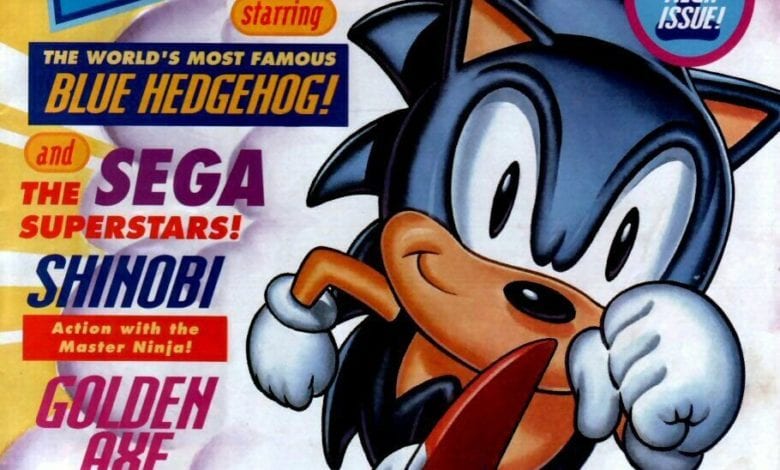
Sonic the Comic: A history of the blue blur’s comic adventures
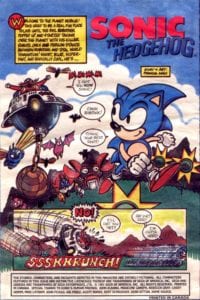
In 1991, one of the ways in which SEGA of America would build hype for the game designed to reverse their fortunes and cement them as a pillar of the video game industry, Sonic the Hedgehog, was to release a free promotional comic that told the story of their daring new blue hero and gave readers a taste of the world in which he resides.
The comic would be featured in a variety of publications of the day, ranging from Electronic Gaming Monthly to Disney Adventures, SEGA’s own answer to Nintendo Power, SEGA Visions, licensed children’s magazines such as Garfield and Teenage Mutant Ninja Turtles, and even other comics from DC, home of Batman and Superman.
Within the pages of the comic (whose length varied according to the publication), readers would discover how a speedy brown hedgehog named Sonic became cool blue, and how the kindly Doctor Ovi Kintobor would be transformed in a freak accident into the sinister Doctor Ivo Robotnik, and why the former needed to beat the latter in a race to collect the six Chaos Emeralds — to say nothing of all those rings.
There would not be a follow-up, per se, as with the way the comic had been written, the adventure was to continue in Sonic the Hedgehog for your SEGA Genesis (it was a promotional comic, after all). Archie Comics would see about launching their own comic book based on the Blue Blur’s adventures in late 1992, but opted to instead base their tales on the worlds seen in the two upcoming DiC animated series, the ABC Saturday morning show Sonic the Hedgehog (colloquially known among fans as “Sonic SatAM”) and the syndicated weekday show, Adventures of Sonic the Hedgehog.
Not so across the pond, however. A United Kingdom-based publisher known as Fleetway decided to publish their own take on the new SEGA mascot’s high-speed adventures, and picked up where the original promotional comic had left off — well, sort of.
“When it comes to reference I remember being provided with photocopies of stuff and a ring binder full of reference material,” former Sonic the Comic writer Nigel Kitching told Mega Visions. “That would have been designed to give to people who were coming up with merchandise. I think, to some extent, SEGA considered the comic to be merchandise. I did see a short comic – maybe the one you refer to — but I cannot remember much about it. I do remember [editor] Richard Burton suggesting I got hold of a book called Stay Sonic [and] I’m pretty sure I took stuff from that.”
Stay Sonic, published by Penguin Books for a UK release in early 1993, was a book which used the backstory as presented in the promotional comic as its foundation. However, while SEGA of America and their associates would go on to ignore the very game-based continuity they had created going forward, it would instead be embraced and built upon in the UK through this book, Sonic the Comic, and other works of fiction until SEGA decided to establish a more unified Sonic brand continuity with Sonic Adventure in 1998.
Sonic the Comic would effectively follow the groundwork laid by this material and pick up the story after the events of Sonic the Hedgehog 2, then the most recent game in the series. Familiar settings, from the Green Hill Zone and Emerald Hill Zone to the Marble Zone and even the Wing Fortress and Death Egg, were often used as the backdrops for new stories.
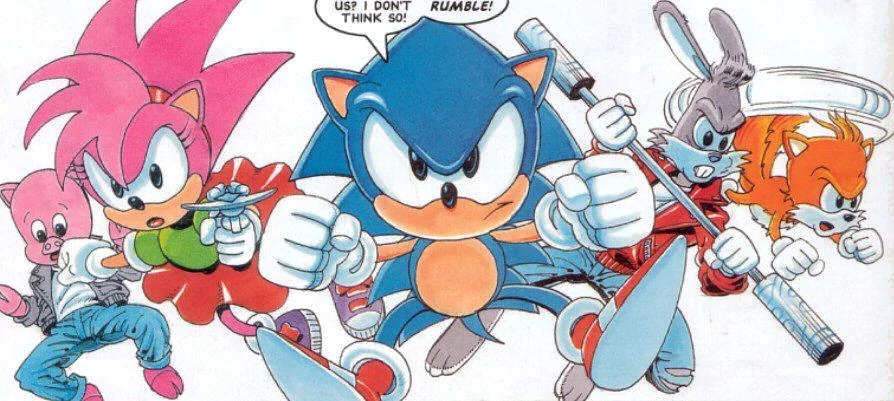
In addition to Tails, Sonic would be joined by other characters based on the animal friends rescued from the Badniks in the games. Alongside Porker Lewis and Johnny Lightfoot, these four would form a rather different version of a team known as the Freedom Fighters.
Said Kitching of the additions to the cast: “I remember looking at (I think this is right) the booklets that came with the games and picking out characters to put into Sonic’s gang. They were pretty blank slates so I had a bit of freedom with them. My favourite was Porker Lewis and I had a lot of fun writing him. I liked his relationship with Sonic.”
Meanwhile, Dr. Robotnik would initially appear very much resembling his in-game depiction, but was soon altered to more closely resemble the version seen in Adventures of Sonic the Hedgehog — a curious juxtaposition with Archie’s use of the “SatAM” character model, as Archie’s earlier stories and Adventures relied more on slapstick, while “SatAM” and Sonic the Comic featured some more serious storytelling.

Of the change, Kitching explains: “When it comes to the visual approach to Sonic, this was down to the style guides given to us by SEGA. I never really thought much about any of the TV series. I do remember that at some point we were asked to change the look of Robotnik. Don’t remember why now. I wrote it into the script just so it wasn’t an unexplained change. I’m afraid I took no interest in the TV series or the Archie comics – I just did my own thing really. Keeping to the guidance from SEGA, of course.”
As time wore on, more additions were soon made to the cast. Amy Rose would join the Freedom Fighters upon the release of Sonic the Hedgehog CD in late 1993, and would show proficiency with a crossbow, in lieu of her yet-to-be-introduced Piko-Piko Hammer from 1996’s Sonic the Fighters. Knuckles would also appear in due time, adding the zones of Angel Island to the mix, and getting into some adventures of his own against such characters as the Marxio Brothers, among others.
Robotnik would find allies of his own, and take on an assistant in his evil schemes: Grimer Wormtongue, his chief scientist and possibly mastermind behind more evil inventions than his more infamous boss. “Grimer was an original character, but he didn’t start out that way,” Kitching recalls. “Initially, I used Snively from a photocopy I’d been provided with. Then I was told that we didn’t have the rights to use him, so he changed into Grimer.”
Other entities would be migrated from the video games into the world of Sonic the Comic, often times being interpreted in a way that seemed radically different from what SEGA presented in, albeit without contradicting the games directly. With the rise of the internet as a place for fans to convene on certain topics in the mid- to late-’90s, some of these concepts became well known even beyond the circles in which Sonic the Comic was published.
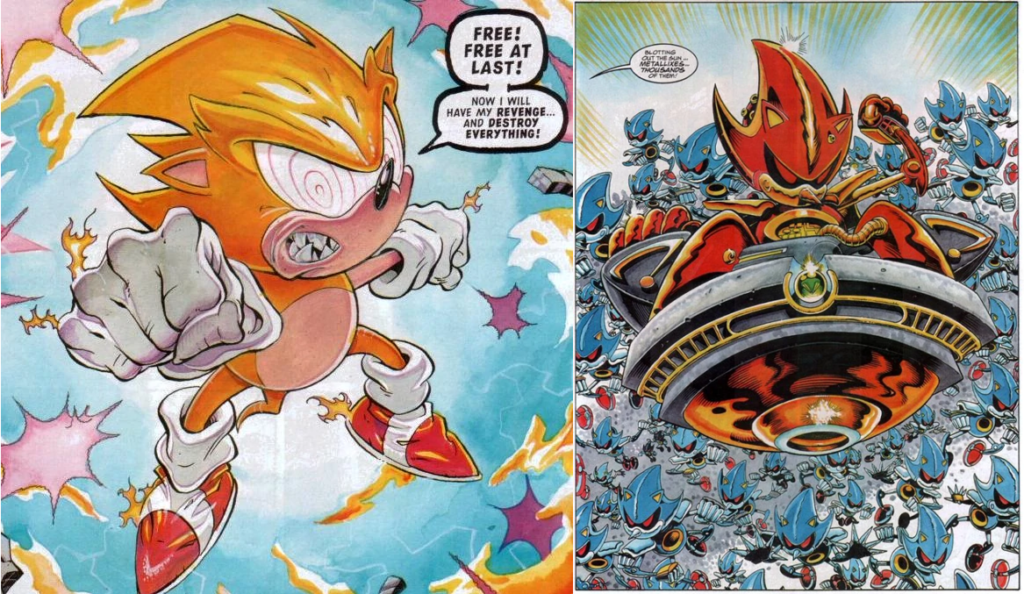
It’s difficult to imagine SEGA allowing such a thing now, but back then? “I think my version of Super Sonic is different to how he is depicted elsewhere, but I wouldn’t really know much about this as I have no idea when it comes to other versions of the Sonic characters,” Kitching stated. “What I do know is what people have told me, so SEGA had no problem at all with my version of Super Sonic. As I say, they were very supportive, but I think things were different back in those days and I’m sure I wouldn’t get away with half of what I did now. Companies are far more protective of their IP nowadays. Some always were of course. But there was a much more relaxed approach from SEGA Europe.
“Once again I loved writing Super Sonic. If I’d been forced to make him another hero it would have been boring –- for me, at least.”
Meanwhile, Metal Sonic would evolve beyond being a singular foe for Sonic, as it and other robotic duplicates such as Knuckles Metallix were part of a legion of such copies known as the “Brotherhood of Metallix.”
“Metallix (named by Richard Burton – my original name [“Metallico”] wasn’t great) was an obvious character to bring from the game into the comic,” Kitching explained to us. “I wanted to make more out of this character than just another enemy for Sonic. I know exactly how I came up with having an army of them. I was inspired by the Daleks in Doctor Who. Doctor Who wasn’t on TV at the time and looked unlikely ever to return, so I felt pretty comfortable taking the Daleks as an inspiration. I’d like to think it was a little bit more than a rip-off, of course.”
As the series wore on, it would continue to evolve from its game-based origins into more of its own entity. “Early on, I felt it made sense to try to get ideas come out of the levels and stories in the games,” Kitching stated. “But as I progressed I became more confident making my personal version of Sonic and coming up with original material to work with.”
This would lead to things looking quite a bit different when it came time for Sonic’s reinvention with the 1999 release of Sonic Adventure for the SEGA Dreamcast. As a result, the comic’s adaptation — which would also serve as its final story arc — looked quite a bit more different from its source material than the likes of Sonic the Hedgehog 3 did years earlier.
However, Sonic the Comic was more than its title lets on… much more, in fact.
Released biweekly (as opposed to the monthly schedule most U.S. comic books tend to follow, in case you were wondering how they reached 223 issues almost a decade before Archie would manage the same!), Sonic the Comic would of course be headlined by one or two Sonic stories each issue, but other stories featured throughout would cover a variety of other SEGA titles, too — sometimes even taking the cover spot from Sonic himself!
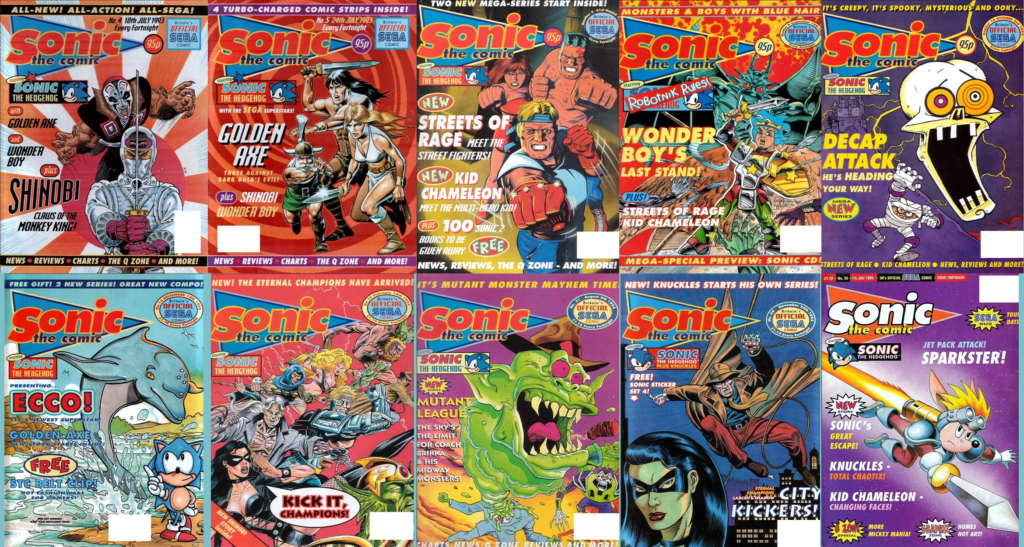
Throughout the early years of the comic’s run, SEGA fans could find multi-part, serialized stories featuring other SEGA Superstars of the day such as Shinobi, Golden Axe, Streets of Rage, Kid Chameleon, Wonder Boy, Ecco the Dolphin, Decap Attack starring Chuck D. Head, Shining Force, and Eternal Champions (who would even get their own separate one-shot issue). Even some titles familiar to SEGA fans but not owned by SEGA themselves got in on the action, including Mutant League Football, Marko’s Magic Football, and Rocket Knight Adventures!
Nigel Kitching would not be the only one to write for Sonic the Comic, as other talent would try their hand at writing the adventures of the Blue Blur and his friends. One such writer was Mark Millar, who also wrote many of the Streets of Rage stories, and who you might recognize for his work on DC Comics’ Superman: Red Son and Marvel Comics’ Ultimate X-Men and The Ultimates (the Ultimate line’s version of The Avengers). Likewise, Kitching would ply his trade in stories based on other games as well, including Streets of Rage, Rocket Knight Adventures, Shining Force, and perhaps most significantly, Decap Attack.
But as vast and varied as the lineup of characters and properties represented were, working on them was largely the same. “The stories in the comic were there because they were the properties owned by SEGA. I don’t quite remember how new strips came about. I may have suggested other strips, but I don’t think so. I do remember that Richard Burton (the editor at the time) phoned me and offered me three games to choose from. We needed a new strip pretty quickly, as I recall. I chose Decap Attack, which worked out pretty well for me. I forget what the alternatives were.”
“Working on Sparkster (Rocket Knight Adventures) was exactly the same process as for anything else,” he added. “As a freelancer, you don’t always know everything that’s going on behind the scenes, of course.”
Sonic the Comic wasn’t just about comics, either. It was a bonafide SEGA magazine, complete with game ranking charts, previews, news, tips (including how to bypass the spinning drum in Sonic the Hedgehog 3‘s Carnival Night Zone!), Q&A, and more, all centered around the current SEGA platforms of the time. You would also occasionally get more editorial-styled articles about topics such as video games getting so many sequels, or gamers’ reactions to the upcoming next generation of hardware. There were also sections for mail and art from fans (who were dubbed with the retroactively regretful moniker “Boomers”), with Sonic prizes available to those who got their submission printed.
If you remember Archie’s Sonic Super Special Magazine, it was quite a bit like that, larger magazine-size format and all, albeit with first-run stories — and available almost two decades earlier.
Unfortunately, for as well-received as it was throughout its run, Sonic the Comic would start to see cutbacks in 1997. The page count was cut from 36 to 32, and much of the gaming news would be lost as a result, and eventually, reprints began being run in the place of back-up comics as another cost-saving measure. By the time the 185th issue arrived in 2000, the magazine had gone entirely to reprints, save for the new covers. This lasted until its 223rd issue, which would be the publication’s last.
That would not mark the end for Sonic the Comic, however. Well, officially, it would, but never underestimate the dedication of a fervent fan base.
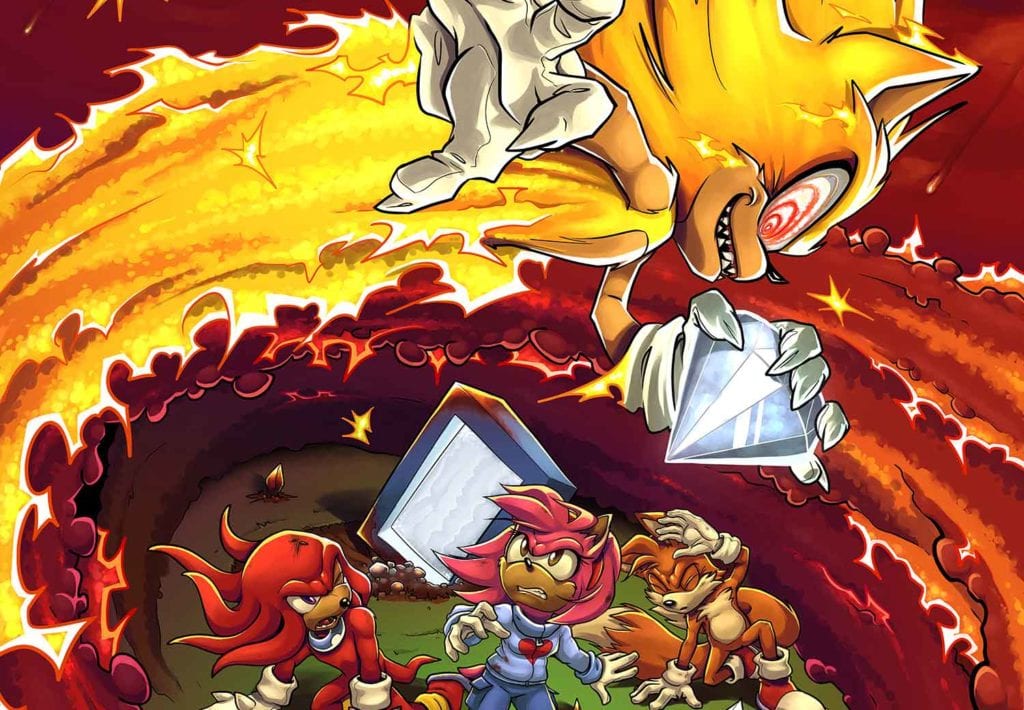
In 2003, the legacy of Sonic the Comic was picked up by “Sonic the Comic Online”, which even picks up the numbering from where Egmont Magazines (nee Fleetway) left off. More than 50 online issues have been posted to their website since, with one special issue in 2018 featuring the return of Sonic the Comic alums Nigel Kitching, Nigel Dobbyn, and Michael Corker returning from the past to look into the future, telling one final epic story to reveal how it all ends.
As it so happens, a lot of comics from years gone by have been picked up again, complete with original creators returning to once again take the reins — Transformers: ReGeneration One with Simon Furman and G.I. Joe: A Real American Hero with Larry Hama being two notable examples. (Both also coming to us from IDW Publishing, who incidentally is the current rights-holder for Sonic the Hedgehog comics, at least in North America.) If Sonic the Comic were somehow able to make a return, would Nigel Kitching be interested in taking up the blue pen?
“If somebody ever approached me to come up with more Sonic material, I would be very interested,” he told us. “I just don’t think it’s likely to happen somehow. In some ways, what we did with Sonic was a product of the situation at the time. Would I now be allowed to write Sonic as a flawed hero? Could I make Super Sonic a homicidal maniac? Today I’d need to approach it differently, I think. But it’s been a while now, and nobody has asked yet. I’m certainly open to offers though.”
On the one hand, nostalgia is big bucks. On the other hand, SEGA seems pretty firmly committed to the modern interpretation of the character… except when they’re not (re: Sonic Boom, Sonic the Hedgehog [2020, Paramount Pictures], and maybe the upcoming Sonic Prime?).
For my part, the biggest disappointment in researching this article by reading a nice stack of issues was the issues I was missing. Many of the stories were engaging and featured some great art, and it was a unique and different take on the Blue Blur from what I’ve seen before. Every time I’d come to a “next issue!” blurb, only to find out I didn’t have it, I was filled with immediate regret.
As a result, even if the series isn’t continued officially, it would still be nice to see some of this material get reprinted somehow. Sure, there are “places” out there where you can find the stories if you look hard enough, but they deserve to be read and appreciated by a wider audience than those likely to find those places, or even think to look.
A HUGE super sonic thanks to Danny Russell from SEGA for inspiring this article and providing reference material, and to Nigel Kitching for taking the time to answer our questions!
Some quotes edited for clarity.

